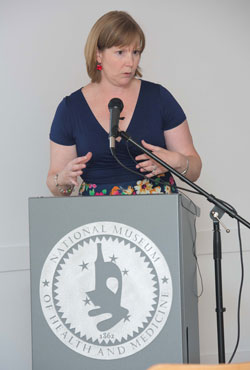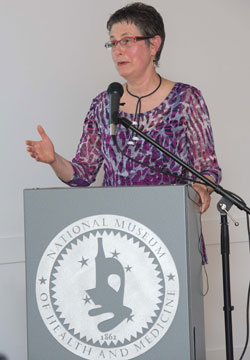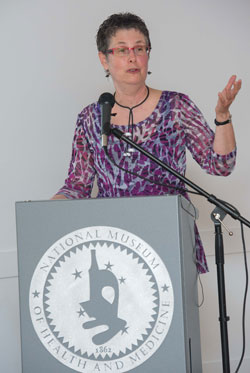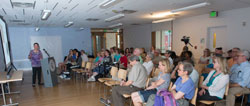Art Complements Science On So Many Levels
By: Paul Bello, National Museum of Health and Medicine
SILVER SPRING, Md. – Supporters of the National Museum of Health and Medicine (NMHM) welcomed Rebecca Kamen, a Virginia sculptor and one-time resident artist with the National Institutes of Health (NIH), to its Medical Museum Science Café at the Silver Spring Civic Building June 24. Her discussion focused on the correlation between art and brain research.
Entitled "Making the Invisible, Visible: Discoveries Between Art and Neuroscience," Kamen discussed how everything in the universe could also be found in the human body. It’s a fact like that, as well as many others, which she says fuels her curiosity about science and helps contribute to her observations as an artist.
"The seeds were planted when I received a chemistry set as a child. I also remember building a telescope with my father when I was nine or ten years old using two paper towel tubes," Kamen said. "Albert Einstein once said, ‘Imagination is more important than knowledge.’ I’ve personally found that to be so true."
During her presentation, Kamen displayed several pieces of art created and interpreted through her own research. One of her larger exhibits included 16 sculptures inspired by Einstein’s discovery of special relativity for an art exhibition at the American Center for Physics at the University of Maryland at College Park.
She also discussed a sculpture inspired by Benjamin Franklin that she had presented during an exhibition at the American Philosophical Society Library in her hometown of Philadelphia, Pa.
In one of her more challenging tasks, however, Kamen spoke of her work with Harvard University and her interpretation of the periodic table of elements. Her artwork is displayed as part of the university’s 21st century online chemistry course created for the Annenberg Learner Series. She plans on working more with Harvard’s Center for Astrophysics on future projects related to her interests in bridging astrophysics and neuroscience.
"I wanted to challenge myself to take a rigid chart like the periodic table and turn it into an object that’s beautiful," Kamen said. "What was created was a garden of atomic flowers inspired by the orbital patterns of electrons from the 83 naturally occurring elements."
The project would only evolve from there, according to Kamen. A full immersion would then take place as she worked with local dancers to interpret the work’s installation and periodic table using dance. This experience serves as another highlight in Kamen’s career, who said it was wonderful to create a piece of art that engages so many people on so many levels.
"A major inspiration of mine is the famed neuroscientist Santiago y Cajal. He believed strongly in looking at things in a new way," Kamen said. "Art is an incredible bridge among creative communities and the people they serve. And yes, the saying is true. Art is in the eye of the beholder."
NMHM's Science Cafés are a regular series of informal talks that connect the mission of the Department of Defense (DoD) museum with the public. NMHM was founded as the Army Medical Museum in 1862 and moved to its new location in Silver Spring, Md. in 2012.
 |
Caption: Andrea Schierkolk, public programs manager at the National Museum of Health and Medicine, offers an introduction to the June 24, 2014 Medical Museum Science Café. The program featured artist Rebecca Kamen and her talk “Making the Invisible, Visible: Discoveries between Art and Neuroscience,” and was held at the Silver Spring Civic Building in Silver Spring, Md. |
 |
Caption: Rebecca Kamen gestures during her recent presentation “Making the Invisible, Visible: Discoveries between Art and Neuroscience,” at the June 24, 2014 Medical Museum Science Café, presented by the National Museum of Health and Medicine. Kamen’s talk focused on the correlation between art and brain research. The program was held at the Silver Spring Civic Building in Silver Spring, Md. |
 |
Caption: Rebecca Kamen gestures during her recent presentation “Making the Invisible, Visible: Discoveries between Art and Neuroscience,” at the June 24, 2014 Medical Museum Science Café, presented by the National Museum of Health and Medicine. Kamen’s talk focused on the correlation between art and brain research. The program was held at the Silver Spring Civic Building in Silver Spring, Md. |
 |
Caption: View of the audience in Fenton Room at the Silver Spring Civic Building in Silver Spring, Md., as artist Rebecca Kamen (standing, far left) offers her presentation “Making the Invisible, Visible: Discoveries between Art and Neuroscience,” at the June 24, 2014 Medical Museum Science Café, presented by the National Museum of Health and Medicine. Kamen’s talk focused on the correlation between art and brain research. |
(Disclosure: These images have been cropped to emphasize the subject.) (National Museum of Health and Medicine photo / Released) |
|



